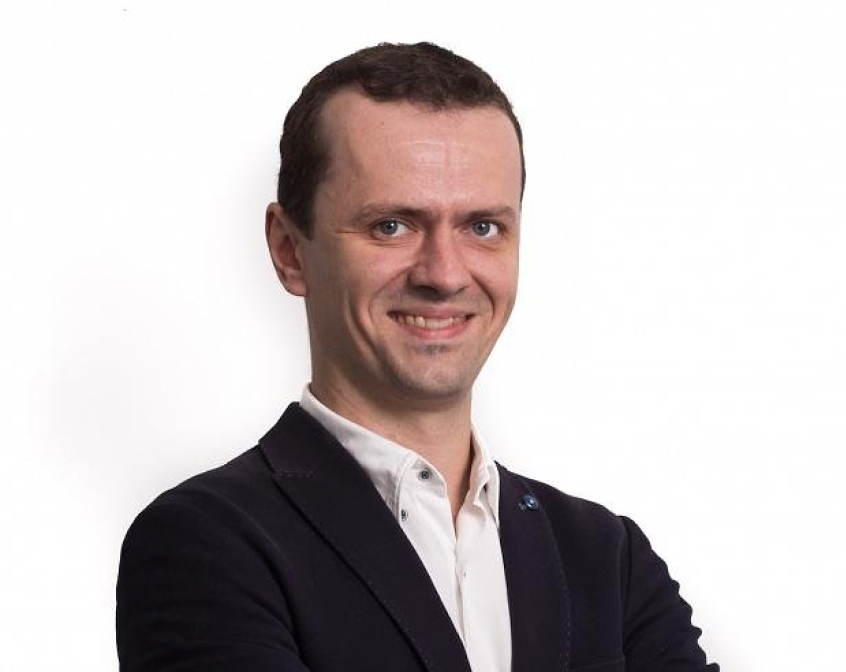As Chief Revenue Officer at Clari, Ben Fiechtner leads a global go-to-market organization for one of the most known software companies in the sales tech ecosystem. As CRO, he develops and executes plans to drive sustainable revenue growth for Clari, and serves global enterprise customers like Adobe, Workday, Cisco, and Okta. Over the course of developing his career in sales, he has scaled highly performant teams, acquired and managed key customers across different markets, and led cross-functional collaboration amongst the many stakeholders in the sales process.
Before joining Clari, Ben was Senior Vice President of Global Key Accounts & Verticals at UiPath where he designed and implemented go-to-market strategies and hired dozens of sales professionals, from individual contributors all the way up to senior leaders. Prior to UiPath, Ben spent more than 9 years as a top sales performer at Salesforce, and he even co-founded an apparel business in his native Wisconsin. Ben knows what it’s like to lead within a corporation with thousands of employees, as well as a two-person small business — that broad context allows him to see sales strategy from a variety of angles. He prefaces his sales philosophy with the idea that there is no definitive right answer in sales; it’s both an art and a science.
Ben recently sat down with Crew Capital’s portfolio companies for a roundtable to discuss one-step vs. two-step sales, direct vs. indirect channels, sales compensation structures for startups, and a variety of other sales-focused topics for startups.
One-step vs. two-step sales process
Whether or not a one-step sales process makes sense for a company depends on the quality of the marketing qualified leads (MQLs), and the size of the organization in Ben’s view. For some organizations, having both a business development representative (BDR) to handle the first step of inbound contact and an account executive (AE) to handle the second step of closing the sale will prove the best way of vetting leads and handing them off to decision-makers. For other organizations, especially smaller ones, one person may have to handle the entire process.
“If it’s a good lead and they’re coming in easily, get them to the person that’s going to land them for you especially if you are a smaller organization,” Ben said. “If you come in and you’re a CRO on my lead form, you automatically go to an AE. I want someone to qualify them quickly, as they likely have budget and are the decision-maker. I want the process for them to be as painless as possible rather than have three meetings to make sure we understand the revenue objective before we try to solve it.”
As for having AEs that specialize in different market segments — such as someone who focuses specifically on medical devices or pharmaceuticals — Ben recommends matching leads to AEs with deep knowledge in the prospective customer’s field.
“What I found is that product-market fit matters the most on that first call. If we’re not speaking the language of the clients, they move on to someone that they think can. Lead routing is both an art and science but magic when you get it right,” he said. “If somebody’s self-selecting in, push to the individual expertise you need. Time over target matters, and I think as a buyer myself, first calls are often wasted.”
Direct vs. indirect channels
Ben has significant experience in both direct and indirect sales; in direct sales, customers buy products or services straight from the vendor, whereas in indirect sales, customers buy through an intermediary, like resellers, distributors, or other partners. Ben’s current company, Clari, focuses more on direct sales, whereas during his time at UiPath, Ben had portions of the revenue going through indirect channels. To him, the decision to focus on one channel or another will depend on the product, the target client, and how much control the company wants over deals.
“If it’s just about reach and cost of sale, what I’ve tried to do that still allows me to have control and drive more scale is to build more tech partnerships,” Ben said. “When working with a tech partner we often will structure a lead pass percentage on qualified leads, but we of course like to run the deal, and of course there are true sell-through motions. Folks may want to buy directly through a reseller, marketplace, or distributor — in that case they are running much more of the cycle. This often scales for Commercial / Mid Market accounts. We just want to ensure our product stickiness, adoption, and utilization are scaled through great partner enablement.” More importantly, Ben advised founders to select channels they can measure in order to A/B test and gauge success over time.
“What I advise our marketing team about new channels, be it social content, SEO, or email marketing — whatever it is, just measure it. Make sure you’re baselining and measuring it and try the top things you think are going to work,” he said.
Ben contrasted that advice with unmeasurable examples, such as taking out ads in The Wall Street Journal or in airports, as brand plays for larger companies. Those examples earn great visibility but prove difficult to measure.
“That’s what the hardest thing is for me. You can’t always measure brand activation in terms of the MQLs that came back, but it is important because brand is still key for market value and perception.”
The revenue tools early-stage startups should use
One of the roundtable questions Ben fielded concerned the best revenue tools for early-stage startups. Founders have almost unlimited options in developing their tech stacks, and while having options is good, narrowing those options to find the best ones can prove daunting. Roundtable members cited dozens of tools they use to automate parts of the sales process, including Clari, Dripify, Apollo, Relevance AI, Nooks, Groove, and Marketo.
Ben said he tries to get his team to live exclusively in Clari and Gmail but they also augment their data/lead process with tools like Champify, Qualified, and Zoominfo. But he emphasized that rather than focusing on any single tool, founders should look to simplify their stack when possible.
“There are so many cool and crazy software applications out there that do different things,” Ben said. “All of them do one or two things really well, but what I try to tell our CIO is to find an application that simplifies my tech stack as much as possible, even if it does the job 80% of the way. I want to make life for sellers as easy as possible — the best way to do that is to minimize the number of tools needed in the process.”
As a tech stack becomes more complex, toggling between tools becomes more complex. This requires increased time and effort to learn how all the tools interact. Additionally, over-complication increases cost. As the number of revenue tools in a tech stack increases, the cost of that tech stack increases, too. Ben recommended simplifying as much as possible.
“The cost can get exorbitant. But more importantly, I sit on the floor with my AEs and ask them ‘How many tools and bookmarks do you need to run your business?’ It gets pretty complicated at previous stops like my time at Salesforce and it’s important to keep this as simple as possible.”
The most common mistakes in building a sales organization
Ben has accomplished a lot in his career, but he’s quick to admit he’s made mistakes, too. He said from his experience in various GTM roles, the No. 1 mistake he sees organizations make is bringing in a new go-to-market sales leader who overhauls everything.
“I think in this macro environment, find out what are the one or two or three things that are mission critical that you’re doing well and are working, and don’t change them,” Ben said. “The mistake I see a lot right now is the amount of people who are recycling their go-to-market or trying to completely pivot their business model because they have a new person. Many people are second-guessing their go-to-market strategies right now and I think there’s a lot of CRO and sales leadership turnover.”
In fact, Durga Pandey and Ben discussed how when they see a company bring in a new CRO, it’s frequently an opportunity for other SaaS companies to target them for sales on products like configure, price, quote (CPQ) software, or other billing tools.
“It’s fascinating to me. I see a new CXO and the number one thing for us is an upsell opportunity or a potential churn opportunity, and you have to get to that person quickly to ensure they understand how to best use your software,” Ben said.
Sales performance benchmarks
Ben emphasized three key focus areas for your go-to market organization: Focusing your attention on your pipeline across how it is flowing through your funnel — creating it, converting it, and closing it.
“I told my team in a QBR recently, ‘If you’re on a call that’s not related to one of those three things, get off of it,'” Ben said. “You’re either creating pipeline, converting pipeline, or closing pipeline. Those are the three buckets.”
Rather than suggesting any specific Key Performance Indicators (KPIs) as more instructive than any other, Ben emphasized making sure that senior leadership focuses on the same metrics at the same time. Most organizations work on a 13-week revenue cycle, and aligning discussions at crucial weeks in the quarter provides greater clarity for everyone.
“Week one from my CEO to me, to my SVPs, to my second-line leaders, to my first-line leaders, to my ICs — they’re looking at the exact same data. They’re looking at slip deal reviews because I want to see which ones we can save quickly to start a quarter fast. They’re looking at the deal-back walk-up against their commits. They know the inventory of deals that are going to get them to the number on week one. Forecast calls, one-on-ones, quarterly business reviews — it all has to be consistent,” Ben said. “Week six, I’m looking at pipeline generation, this quarter plus one. I’m looking at conversion, stalled pipeline opportunities without a next step, and the number of opportunities that haven’t been touched in the last 30 days.”
Creating data synergy across the organization allows a CRO like Ben to better assess the efficacy of various wings of his sales organization.
“We can then manage by exception to say which teams are working well, which teams are missing, which teams have a pipeline creation problem, which teams have a conversion problem, which teams have an execution problem,” he said. “Then I can enable a change. I can drive more big deal reviews for this team that isn’t closing well. I can help these folks with sales programs based on those that have struggles with the top of the funnel. I think the biggest learning for me is how to drive that consistency across your entire sales organization on the right metrics on the right date so that you can have visibility into who’s skewing from the average and who can I help coach and spend extra time with.”
Variable vs. fixed salary sales compensation
When it comes to sales compensation, Ben strongly believes that salespeople should earn commissions and not rely on fixed salaries. Working in sales, in his opinion, should mean that someone should be paid in line with their ability to sell.
“The reason you’re a seller is because you want upside and are willing to take the risk that comes with it. I may be old school this way, but I’m a firm believer that you should pay salespeople who perform a disproportionate amount of money because great salespeople are precious and you should handsomely reward those who are unbelievable at it. Variability drives the right behavior to drive over-achievement and have folks focus on the right things that drive the number,” Ben said.
He explained that the lead routing process did need to be fair, but that variable compensation matched the right people for sales positions. He said that if an SE/CSM wants to become an AE, but hears that base compensation will decrease and total compensation will shift from 70% base and 30% commission to 50% base and 50% commission, many times that person won’t change positions unless they are truly hungry and ready to take on the risk/reward.
“I like having GTM Orgs (in almost all roles) on incentive-based compensation packages — you want folks to see the fruits of their labor and be paid for their contributions to the business,” he said. “And I find that the top talent always wants to be paid for their work and the deals they are attached to.”
Related Articles

From Report Factory to Revenue Oracle: John Queally on the RevOps Transformation
John Queally, Senior Director of Revenue Operations at Clari, has witnessed this evolution firsthand. His vision of revenue operations (RevOps)…

Vlad Ionescu: An Early-Stage Startup Marketing Masterclass: Part I
Crew Capital’s Dylan Reider and Sonia Damian recently sat down with Vlad Ionescu for a two-part interview featuring a wide-ranging…









